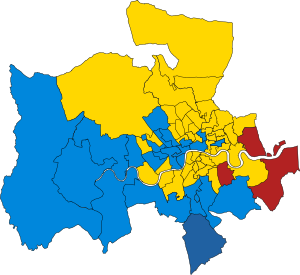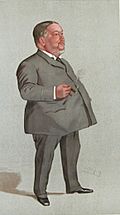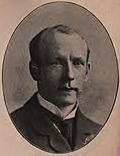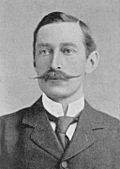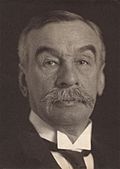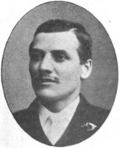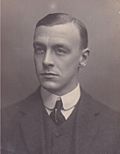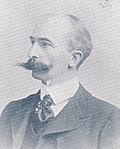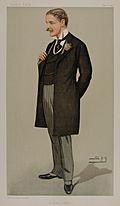Croydon (UK Parliament constituency) facts for kids
Quick facts for kids {{{Name}}}[[{{{Type}}} constituency]] |
|
|---|---|
| [[Image:{{{Map1}}}Constituency.svg|120px|]] [[Image:England{{{Map2}}}.svg|120px|]] |
|
| {{{Name}}} shown within [[{{{Entity}}}]], and {{{Entity}}} shown within England | |
| Created: | {{{Year}}} |
| MP: | {{{MP}}} |
| Party: | {{{Party}}} |
| Type: | House of Commons |
| County: | [[{{{County}}}]] |
| EP constituency: | [[{{{EP}}} (European Parliament constituency)|{{{EP}}}]] |
Croydon was an area in the United Kingdom that elected a single person to represent it in the House of Commons. This is the main part of the UK Parliament. The Croydon constituency existed from 1885 to 1918.
The person elected was called a Member of Parliament (MP). They were chosen using the "first past the post" system. This means the candidate with the most votes wins, even if they don't get more than half of all votes.
For most of its history, the Croydon seat was won by the Conservative Party. However, from 1906 to 1909, a different party won. This was the Liberal Unionist Party, which was allied with the Conservatives. Their candidate, H. O. Arnold-Forster, won by a small margin in 1906. This was during a time when the main Liberal Party won a lot of seats across the country.
Arnold-Forster sadly passed away in 1909. This led to a special election called a by-election. After this, the Liberal Unionist Party stopped putting forward candidates for Croydon. The Labour Party also tried to win the seat in 1906 and 1909, but they didn't get many votes.
Contents
What Area Did Croydon Represent?
Boundaries from 1885 to 1918
The Croydon constituency covered the area of the town of Croydon. Croydon was a "Municipal Borough" from 1883. This meant it had its own local government. In 1889, it became a "County Borough," which gave it even more local control.
By 1902, the area used for parliamentary elections was the same as the area for local government. Croydon was located in the north-east of Surrey county. Since 1965, this area has been part of Greater London.
After 1918, the Croydon constituency was split into two new areas: Croydon North and Croydon South.
A Look at Croydon's History in Parliament
The Croydon area was very close to London. Many people living there traveled to work in the City of London every day.
In the early 1900s, more factories were built in Croydon. This meant many working-class people moved into the area, especially in the northern parts.
Even though it was a commuter area, Croydon was generally a Conservative voting area. However, it wasn't as strongly Conservative as some other areas around London. For example, in the 1906 election, the Labour Party managed to get 20% of the votes.
Why "Borough" Was Important
Croydon was known as a "parliamentary borough." This was different from a "county seat." Being a borough meant that there were limits on how much money candidates could spend on their election campaigns. It also affected who was in charge of running the election.
Who Were Croydon's MPs?
Here are the people who represented Croydon in Parliament:
| Year | Member | Party | |
|---|---|---|---|
| 1885 | William Grantham | Conservative | |
| 1886 | Sidney Herbert | Conservative | |
| 1895 | Charles Ritchie | Conservative | |
| 1906 | H. O. Arnold-Forster | Liberal Unionist | |
| 1909 | Sir Robert Hermon-Hodge | Conservative | |
| 1910 | Ian Malcolm | Conservative | |
| 1918 | constituency abolished | ||
Election Results: Who Won When?
The Croydon constituency saw several elections during its time. Here's a look at some of the results:
Elections in the 1880s
In the first election in 1885, William Grantham from the Conservative Party won. He received 56% of the votes. The Liberal candidate, Jabez Balfour, got 44%.
Grantham later resigned, leading to a special by-election in January 1886. Sidney Herbert, a Conservative, won this election with 53.9% of the votes. He beat Sydney Buxton from the Liberal Party.
Later in 1886, there was another general election. Sidney Herbert was re-elected without anyone running against him. He was also re-elected unopposed in a by-election in August 1886.
Elections in the 1890s
In the 1892 general election, Sidney Herbert (Conservative) won again. He received 57.5% of the votes.
When Herbert became a "peer" (a member of the House of Lords), he had to leave his seat in the House of Commons. This caused a by-election in May 1895. Charles Ritchie, a Conservative, won this by-election without any opposition.
Ritchie then became a government minister, which meant another by-election in July 1895. He was again elected unopposed.
In the general election of 1895, Charles Ritchie (Conservative) won the seat again with 59.7% of the votes.
Elections in the 1900s
In the 1900 general election, Charles Ritchie (Conservative) was once more elected without any opposition.
The 1906 general election was different. H. O. Arnold-Forster from the Liberal Unionist Party won with 41.5% of the votes. This was a close contest with the Liberal candidate, Henry Somerset (38.3%), and the Labour candidate, Sidney Stranks (20.2%).
After Arnold-Forster's death, a by-election was held in 1909. Robert Hermon-Hodge from the Conservative Party won this election with 57.4% of the votes. He beat John Raphael (Liberal) and Frank Smith (Labour).
Elections in the 1910s
In the general election of January 1910, Robert Hermon-Hodge (Conservative) won again with 51.9% of the votes. He was challenged by Arthur Lewis Leon from the Liberal Party.
In the next general election in December 1910, Ian Malcolm from the Conservative Party won the seat with 53.4% of the votes. He also ran against Arthur Lewis Leon.
The Croydon constituency was officially ended in 1918.
See also
- List of former United Kingdom Parliament constituencies
Images for kids


